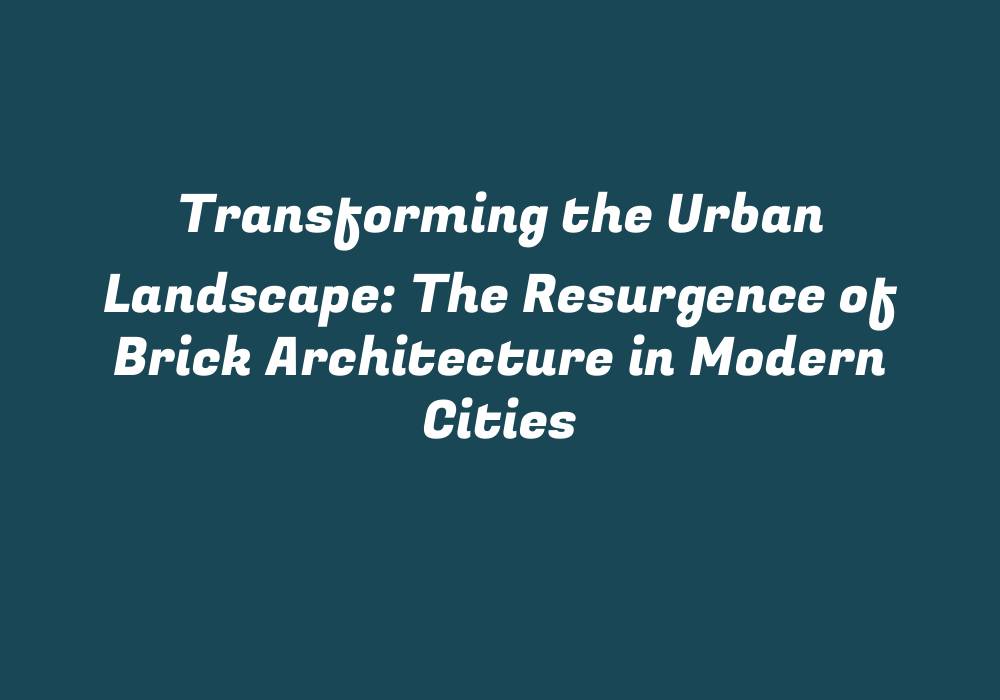Transforming the Urban Landscape: The Resurgence of Brick Architecture in Modern Cities
Architectural styles have experienced a significant evolution over time, adapting to changing needs and societal preferences. As cities continue to grow and evolve, architects are exploring innovative ways to create more sustainable and aesthetically pleasing designs. One of the most promising developments in this area is the resurgence of brick architecture in modern urban landscapes.
Brick Architecture’s Historical Roots
Brick has a rich history as an architectural material, dating back to ancient civilizations like the Mesopotamians, Greeks, and Romans. Initially used for building walls, bricks gradually transformed into a versatile material for constructing structures and decorating interiors. Its widespread use in Europe during the Roman Empire and throughout the medieval era solidified brick’s role as a fundamental part of architectural heritage.
Sustainability and Brick Architecture
In today’s rapidly changing world, sustainability has become a crucial aspect of architecture. Urban areas are grappling with issues like climate change, energy consumption, and resource depletion, leading to a shift in architectural focus towards materials that can address these concerns. Brick is an eco-friendly and environmentally conscious option for several reasons:
Reduced Carbon Footprint
Bricks are manufactured using raw materials like clay, shale, or sand that are readily available worldwide. Manufacturing bricks consumes less energy compared to other building materials and has a relatively low carbon footprint. Moreover, bricks can be easily recycled for other uses at the end of their life cycle, making them a sustainable choice for both construction and demolition.
Thermal Mass and Energy Efficiency
Brick structures possess excellent thermal mass properties due to their inherent high heat capacity. This means they can store heat during the day, releasing it at night when temperatures cool down. This ability to retain warmth reduces the need for artificial heating in buildings and contributes to increased energy efficiency.
Natural Air Purification
Brick is a highly porous material that naturally absorbs and releases moisture, which helps purify the air. As they age, bricks’ pores become even more open, allowing for increased air filtration. This natural air-cleaning function can significantly improve indoor air quality and promote better health in urban environments.
Brick Architecture: Aesthetic Appeal
Apart from its sustainability aspects, brick architecture also appeals to the human eye for various reasons:
Versatility and Design Flexibility
Bricks can be used in numerous ways to create various textures and patterns on both interior and exterior walls. Their inherent plasticity allows architects to experiment with different forms, colors, and patterns for a unique visual appeal. The combination of brick and other materials like steel, wood, or glass adds depth and character to urban landscapes.
Timeless Beauty
Brick architecture has a rich history and is known for its timeless aesthetic appeal. Unlike some modern materials that may become dated or out of style, brick structures possess an enduring charm that can withstand the test of time. This makes them suitable for both historical renovations and contemporary designs.
Modern Brick Architecture in Urban Environments
In recent years, architects around the globe have embraced the potential of brick architecture in modern cityscapes. Some notable examples include:
Huaxi Building, China
Designed by Steven Holl Architects, this structure features a unique arrangement of irregularly shaped, red-brick boxes suspended in the air. The Huaxi Building’s striking appearance stands out among other skyscrapers and contributes to the vibrant urban fabric of Shanghai.
Khan Yar Mosque, Pakistan
This stunning mosque designed by Maki and Associates is built with 9.5 million red bricks. The use of brick not only adds to the building’s aesthetic appeal but also emphasizes the importance of traditional Islamic architecture in modern contexts.
Ashgabat International Airport, Turkmenistan
The terminal at Ashgabat International Airport by Tabanlioglu Architecture and Urban Design features a stunning façade constructed using 4.5 million red bricks laid in a pattern inspired by the region’s carpet weaving tradition. This design pays homage to Turkmenistan’s cultural heritage while creating a visually striking structure for this critical transportation hub.
Pier 7, Australia
This mixed-use waterfront development in Sydney by CHROFI Architects is an excellent example of how brick can be used to create a cohesive and visually striking urban landscape. The use of clay bricks adds warmth and texture to the buildings while complementing the surrounding natural environment.
Conclusion
As cities continue to evolve, architects are increasingly embracing brick architecture as a means of creating sustainable, visually appealing, and culturally relevant urban landscapes. The resurgence of this timeless material demonstrates its ability to adapt to new challenges while preserving the unique character that has made it such an enduring part of our built environment.
References
1. “China’s New Huaxi Building: Red Brick as a Modern Skyscraper,” Architectural Digest, 2020, https://www.architecturaldigest.com/story/chinas-new-huaxi-building-red-brick-as-a-modern-skyscraper
2. “Huaxi Building, Shanghai – Steven Holl Architects,” ArchDaily, 2018, https://www.archdaily.com/679483/huaxi-building-shanghai-steven-holl-architects
3. “Khan Yar Mosque by Maki and Associates – Architecture & Design,” ArchDaily, 2019, https://www.archdaily.com/935765/khan-yar-mosque-by-maki-and-associates-architects
4. “New Ashgabat Airport Terminal by Tabanlioglu Architecture & Urban Design,” ArchDaily, 2018, https://www.archdaily.com/917581/new-ashgabat-airport-terminal-by-tabanlioglu-architecture-urban-design
5. “Pier 7 Redevelopment by CHROFI Architects,” ArchDaily, 2017, https://www.archdaily.com/890462/pier-7-redevelopment-by-chrofi-architects
